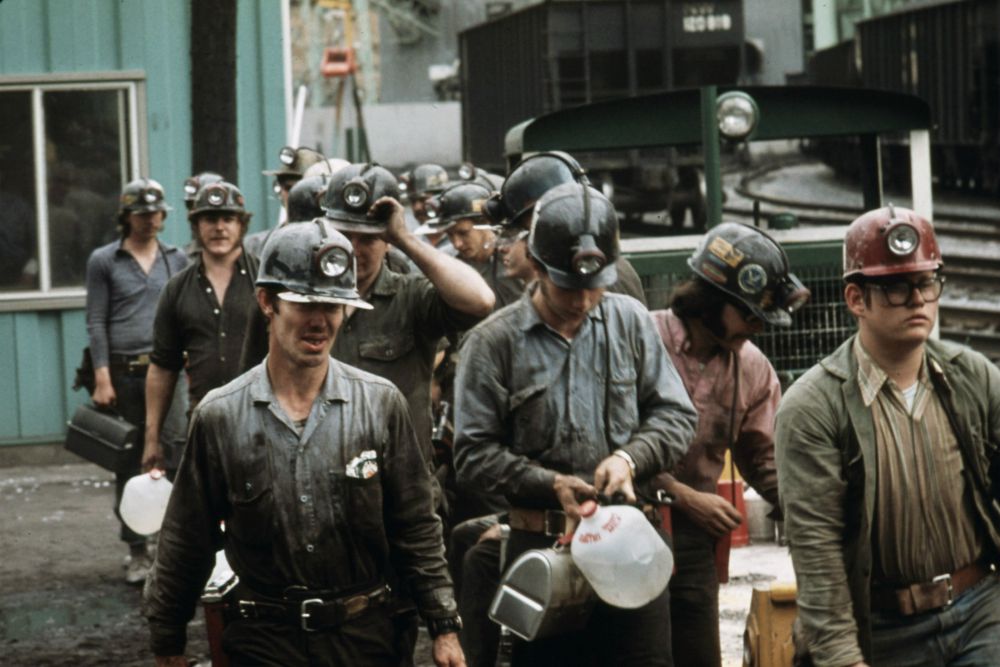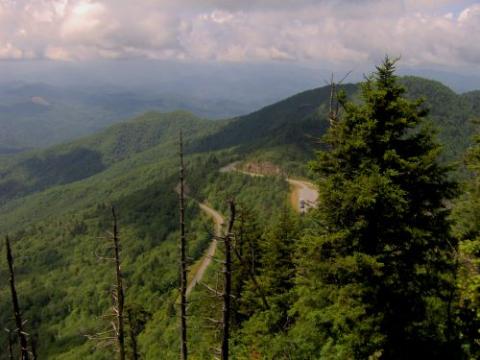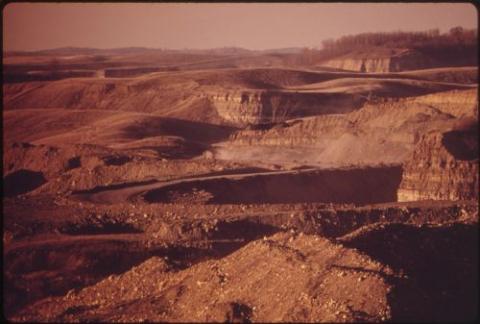
Miners line up to go into the elevator shaft at the Virginia-Pocahontas coal company mine #4 near Richlands, Virginia, April 1974 (Wikimedia Commons/U.S. National Archives/Environmental Protection Agency/Jack Corn)
On Christmas Day, Salt + Light TV will debut its new documentary "Magisterium of the People: The Story of the People's Pastoral from the Catholic Committee of Appalachia." I am not a film critic, but I encourage everyone with cable TV access to watch this film. It is splendid.
The story centers around the history of this Catholic committee (the CCA) and the three pastoral letters it helped issue. Founded back in 1970 in this part of the country, where only about one percent of the population lives, the Catholic Committee of Appalachia was co-founded by Congregation of Notre Dame Sr. Beth Davies, who is interviewed throughout the documentary. An outgrowth of the Catholic Worker movement, the committee at first got together for an annual retreat. "Through that networking came opportunities to oppose strip mining, to work for the elimination of black lung, [for] safety in the mines, various things like that," she explains. Davies emphasizes how critical listening has been to the charism of the group.
Another co-founder of the committee is Glenmary Fr. John Rausch. He describes the essence of the group: "CCA over the years has just been this reflective response from the church, and they did that especially through these three pastoral letters, the first in 1975." Entitled "This Land is Home to Me," that first pastoral was issued by the Catholic bishops of the region, although Rausch explains its principal author was Joe Holland who now teaches at St. Thomas University in Miami. The bishop back then would even come to CCA meetings.

Blue Ridge Parkway, left, viewed from 6,292-foot summit of Waterrock Knob in North Carolina, June 2008 (Wikimedia Commons/Brian Stansberry)
The second pastoral, "At Home in the Web of Life," was issued in 1995. Sr. Davies reflects on its themes saying, "We thought it would be groundbreaking, and we realized after it came out, it was way ahead of its time. … We've been asked for many more copies of that document years later, when really it became the whole story of the environment, environmental justice and sustainability, and that came about." Later, towards the end of the documentary, Davies and Rausch speak about their excitement when Pope Francis issued his encyclical "Laudato Si': On Care for Our Common Home."
"It was like getting a Christmas card from God," Rauch says.
Sadly, in 2015, when the CCA wanted to issue a third pastoral letter, the bishops of the region were no longer interested. The church had entered its self-referential mode. Bishop Michael Bransfield of Wheeling-Charleston, West Virginia, would issue extraordinarily well done pastorals on the poor and the elderly, but the energy for social justice had gone out of most of the bishops. Nonetheless, the group felt called to continue the tradition, and the result was "a people's pastoral." I do not want to give away the whole plot. Suffice it to say that the documentary discusses the drafting, the points of view, and the Spirit-filled effort to issue this third people's pastoral letter.
The documentary cameras also visit a small Benedictine monastery in Kentucky. "The first pastoral letter called for centers of prayer and reflection. … How are you going to make it go if only Catholics come?" asks Benedictine Sr. Judy Yunker. "From the beginning, we didn't only stay within the Catholic community." She discusses her work at the food pantry, the poverty of the region, the lack of employment, the absence of hope. This Catholic witness of the sisters in the region is remarkable, not least because they recruited new members at a time when most religious orders were losing them.

Land mined by Hanna Coal Company in Southeast Ohio, pictured in October 1973 (Wikimedia Commons/U.S. National Archives/Environmental Protection Agency/Erik Calonius)
Later in the documentary, the viewer follows Social Service Sr. Simone Campbell around Washington, D.C., on her bike, then as she climbs the steps of the U.S. Capitol and visits with members of Congress. She explains how her work builds on, indeed is dependent upon, the stories of the women religious in Appalachia. Daughter of Charity Sr. Carol Keehan, president of the Catholic Health Association, talks about the relationship of clean water and air to health and, more broadly, about the challenges of providing health care to the poor. "These people will never get a voice in the public forum unless the church uses its voice to speak for them and to demand that they be paid attention to," she says firmly and with all the formidableness we have come to expect from her. There is a note of hope at the very end when Bishop John Stowe is installed as Bishop of Lexington, Kentucky, and he calls Fr. Rausch and asks him to introduce him around the area. Stowe would send the people's pastoral to every bishop in the country.
The story of Christian witness, in this documentary and throughout history, is filled with notes of hope, but the dominant theme of this documentary is a dark one. The pastoral letters are not heeded. Fracking is introduced. Strip mining gives way to mountain-top removal, which is described as "strip mining on steroids." It pollutes the air as it destroys the land. And when the coal is gone, so are the jobs, so is the hope. If you are looking for an easy pick-me-up on Christmas Day, this is not the film for you.
It is, however, a deeply moving Christmas story. Several medieval and renaissance artists would picture the Christ child asleep on the cross, or holding on to a cross as he nestled in his mother's arms. Despite the angels' promise, the birth of Christ did not bring peace on Earth; the shadow of the cross manifests itself, even at Yuletide. This documentary belongs to that lineage. Appalachia has been crucified by the extraction industries and the politicians they have been able to buy. The priests, nuns and lay faithful bring the Christ child into that dark and dreary world; indeed, they are the Body of Christ in that world. They are the light amidst the darkness, but the darkness is never entirely dispelled. Once again, we see how our pilgrim faith in Christ changes nothing, and everything.
[Michael Sean Winters covers the nexus of religion and politics for NCR.]
Editor's note: Don't miss out on Michael Sean Winters' latest: Sign up to receive free newsletters and we'll notify you when he publishes new Distinctly Catholic columns.
Advertisement







